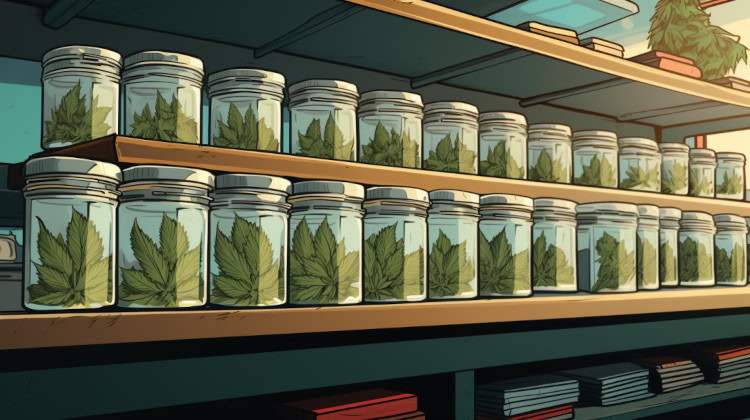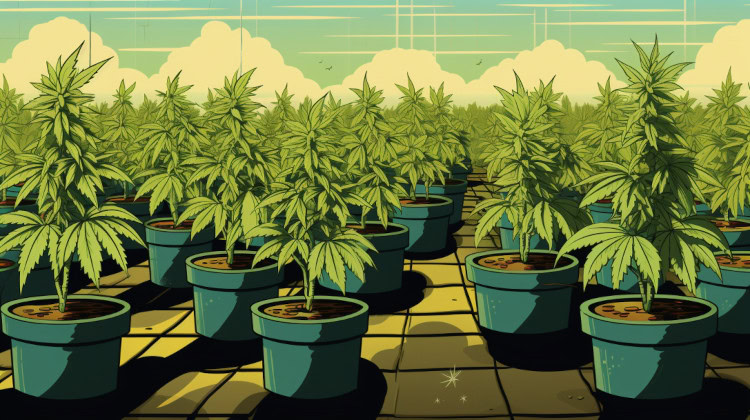Key Takeaways
- Look for myrcene, limonene, linalool, pinene, and caryophyllene when coping with PTSD symptoms.
- Combos of pinene and caryophyllene or pinene and linalool may offer possible PTSD relief.
- Patients highly recommend strains like Amnesia Haze, Strawberry Cough, or Member Berry.
If you are among the 12-13 million Americans battling post-traumatic stress disorder (PTSD), you may have wondered what is the best remedy for anxiety, depression, and insomnia.
Many people with PTSD use cannabis to treat these common symptoms, so much so that PTSD is a qualifying condition for medical cannabis in nearly every medical cannabis state but Alaska and South Dakota.
Consumers often use cannabis terpenes as a guide to help them find the best strain for their PTSD to ensure optimum relief.
Which Terpenes Help Most With PTSD?
Existing studies exploring the best terpenes for PTSD are limited. Nonetheless, these studies signify that certain cannabis terpenes may provide some level of respite for PTSD patients, depending on the dosage and potency.
Although there is promising research to support cannabis use for PTSD symptoms, it's essential to remember that everyone reacts to cannabis differently. What is helpful to one patient may not work the same for someone else, even if they have the same symptoms.
To properly navigate finding the best terpenes for PTSD, it's crucial to consider the seriousness of the mental illness. Symptom severity varies from case to case. While one patient with PTSD may experience more intense night terrors and insomnia, others might struggle with bouts of psychological distress. Patients should consult with their doctor to discuss what symptoms may benefit from cannabis use.
Cannabis’ most abundant terpenes include myrcene, caryophyllene, and limonene. Caryophyllene and myrcene show promise as potential pain relievers, antioxidants, anti-anxiety, and anti-inflammatory agents.1,2 Rodent studies suggest that limonene exerts anti-anxiety, motor-relaxant, and sedative effects.3
PTSD patients may find anxiety relief with pinene, found in a number of plants and essential oils. Pinene is a compound with widespread potential medicinal benefits. It is a potential sleep aid with anti-inflammatory, anti-anxiety, and neuroprotective properties.4 One research effort explored the effects of inhaled α-pinene 90 minutes after exposure and found that anti-anxiety effects occurred.5
Rodent studies on the essential oil of neroli oil reveal potential anti-anxiety effects. Based on the outcome of one randomized controlled trial, neroli oil inhalation among postmenopausal women enhanced quality of life by easing menopausal symptoms, reducing blood pressure, and increasing libido. Furthermore, the researchers emphasized how neroli oil may exert anti-stress effects by invigorating the endocrine system.2
Other terpenes that may benefit PTSD anxiety symptoms include linalool, terpinolene, terpinene, phellandrene, delta carene, guiaol, and eucalyptol.6
Research reflects the fatigue-fighting capabilities of terpenes found in thyme linalool essential oil. This oil contains 51.2% linalool and 14.0% terpinen-4-ol, an isomer of the cannabis terpene terpineol.
Researchers hypothesized that inhalable thyme linalool may reduce fatigue via an anti-inflammatory process after neuron activation. They noted that they were unsure whether thyme’s anti-fatigue properties transpired from linalool or (+)-terpinen-4-ol. However, the team did not deny that both molecules may harbor anti-fatigue powers.5
If you need further assistance finding suitable terpenes for PTSD, a budtender may be able to guide you toward a strain with an appropriate terpene profile for your symptoms. However, it’s best to consult with your medical provider first, especially if you are taking any medications.
Which Terpene Combinations Help Most With PTSD?

Patients with PTSD typically prefer strains with high levels of terpenes like myrcene, pinene, and caryophyllene. These can include cultivars like Cannatonic, Blue Dream, and Harlequin. OG Kush is another favorite, containing caryophyllene, myrcene, and limonene. Jack Herer is another commonly used strain for PTSD, and it contains caryophyllene, pinene, and terpinolene.
Together, caryophyllene and pinene may provide PTSD patients with anxiety and stress relief. Pinene may pair best with linalool to provide antidepressant effects. Separately, myrcene may provide PTSD patients with relief from insomnia and disturbed sleep, pain, and anxiety, whereas limonene is preferred as a potent anxiety reliever.2,1
How to Choose Strains for PTSD Based on Terpenes
A physician evaluation is the best first step to treating PTSD symptoms with cannabis terpenes. Once patients receive an evaluation, they should consider the main symptoms that interfere with daily life. Identifying the symptoms will simplify the process of choosing the best strains and terpenes for PTSD.
Consider the following factors to narrow down your options:
- Preferred Aromatic Profile—Patients must consider their desired smells and flavors. It is often said that “the nose knows,” meaning if it smells good to you, you’ll most likely enjoy the consumption experience. When choosing a strain for PTSD, look for terpenes known to ease specific PTSD symptoms, like myrcene, pinene, and caryophyllene. These are just a few of the hundreds of terpenes found in cannabis, so there may be others that suit different symptoms. Use an online strain database to help determine the effects and prevalence of each terpene.
- Certificate of Analysis—When choosing the best terpenes for PTSD, ask to see the certificate of analysis (COA). Reputable companies must test their products for potency, safety, and composition, which is a good way to determine exactly what they contain.
Beyond terpenes, consumers with PTSD may also want to consider the following when they are choosing a strain:
- Cannabinoid Ratio—For those looking to relieve their symptoms without any intoxicating effects they may want to opt for a high-CBD product. More experienced users looking for relief from certain symptoms may benefit better from a high-THC option. There are many other ratios in between.
- Dosage and Potency—It is especially important for beginner cannabis users to know the potency of their cannabis pre-consumption. It is best to start low and slow, only increasing the dose if you feel comfortable and in moderate doses. Lab-tested products should have the dose clearly listed on the package.
- Different methods—When selecting a strain, consider your preferred method of consumption, such as smoking, vaping, tinctures, or edibles. Smoking and vaping will have a more rapid onset time with a shorter duration of effects, while tinctures and edibles will have a longer onset time and longer duration of effects.
The 5 Best Strains for PTSD Based on Terpenes

Discussing options for cannabis and PTSD symptoms with a certified medical cannabis doctor and a professional budtender is advised.
Below is a list of five of the most consumer-recommended strains for PTSD.
Strawberry Cough
This strain is a fruity mixture of Strawberry Fields and an unknown Haze strain. Some users report feeling more sociable after consuming Strawberry Cough, hailed as a stress reliever, anti-inflammatory, and painkiller. Terpenes include myrcene, pinene, and caryophyllene.
Amnesia Haze
If you're searching for a strain that provides mostly cerebral effects, consider Amnesia Haze. Many consumers note its clear-headed, energizing high effects and its citrus-earthy terpene profile. Amnesia Haze’s terpenes include myrcene, caryophyllene, and limonene.
Member Berry
A fruity favorite among medical cannabis patients, the parent strains are Mandarin Sunset and Skunkberry. Member Berry inherits some calming terpenes like caryophyllene, myrcene, and humulene, which may contribute to this strain's stress-busting, pain-relieving, and anxiety-reducing properties. It may also help with depression, appetite loss, and nausea. The high is reported to be long-lasting and surfaces quickly.
GG4
GG4 is definitely worth mentioning on the list of the best strains for PTSD. This award-winning cultivar, which gets its abbreviated name from its original name, “Gorilla Glue #4,” contains 20-33% THC. Recommended as an aid for depression, stress, and pain, the strain also enhances creativity and focus in controlled doses. Examples of this strain’s terpenes for PTSD include caryophyllene, myrcene, and limonene.
Gelato
Gelato is a dessert-like strain. Breeders combined a delicious Sunset Sherbet and Thin Mint Girl Scout Cookies duo to create this potential anxiety-relieving strain. PTSD patients with a high THC tolerance may enjoy Gelato. The sweet flavor melds nutty and vanilla notes, and consumption may increase appetite. Consumers report feeling happier and less anxious in social situations after consuming Gelato. Its terpenes are caryophyllene, limonene, and humulene.
References
- Scandiffio R, Geddo F, Cottone E, et al. Protective Effects of (E)-β-Caryophyllene (BCP) in Chronic Inflammation. Nutrients. 2020;12(11):E3273. doi:https://doi.org/10.3390/nu12113273 ↩︎
- Surendran S, Qassadi F, Surendran G, Lilley D, Heinrich M. Myrcene—What Are the Potential Health Benefits of This Flavouring and Aroma Agent? Frontiers in Nutrition. 2021;8. doi:https://doi.org/10.3389/fnut.2021.699666 ↩︎
- Choi SY, Kang P, Lee HS, Seol GH. Effects of Inhalation of Essential Oil of Citrus aurantium L. var. amara on Menopausal Symptoms, Stress, and Estrogen in Postmenopausal Women: A Randomized Controlled Trial. Evidence-based Complementary and Alternative Medicine : eCAM. 2014;2014(1). doi:https://doi.org/10.1155/2014/796518 ↩︎
- Weston-Green K, Clunas H, Jimenez Naranjo C. A Review of the Potential Use of Pinene and Linalool as Terpene-Based Medicines for Brain Health: Discovering Novel Therapeutics in the Flavours and Fragrances of Cannabis. Frontiers in Psychiatry. 2021;12. doi:https://doi.org/10.3389/fpsyt.2021.583211 ↩︎
- Masuo Y, Satou T, Takemoto H, Koike K. Smell and Stress Response in the Brain: Review of the Connection between Chemistry and Neuropharmacology. Molecules. 2021; 26(9):2571. https://doi.org/10.3390/molecules26092571 ↩︎
- Kamal BS, Kamal F, Lantela DE. Cannabis and the Anxiety of Fragmentation-A Systems Approach for Finding an Anxiolytic Cannabis Chemotype. Front Neurosci. 2018;12:730. Published 2018 Oct 22. doi:10.3389/fnins.2018.00730 ↩︎
The information in this article and any included images or charts are for educational purposes only. This information is neither a substitute for, nor does it replace, professional legal advice or medical advice, diagnosis, or treatment. If you have any concerns or questions about laws, regulations, or your health, you should always consult with an attorney, physician or other licensed professional.




